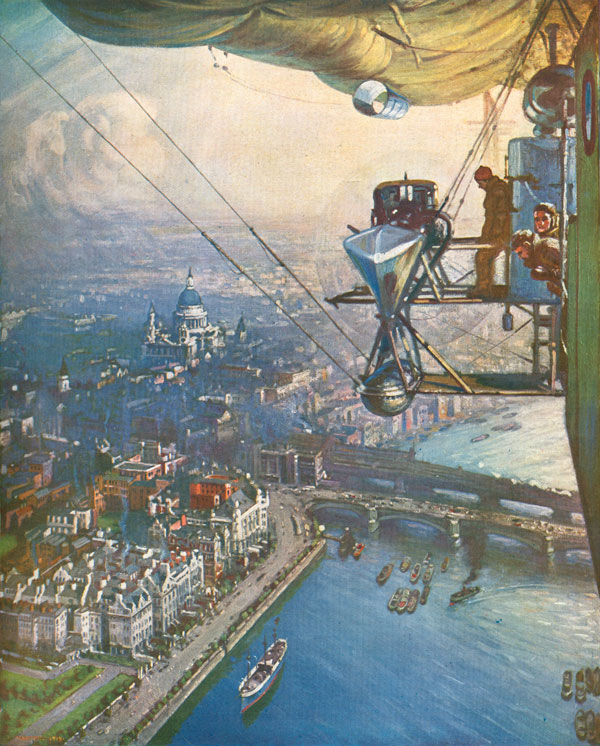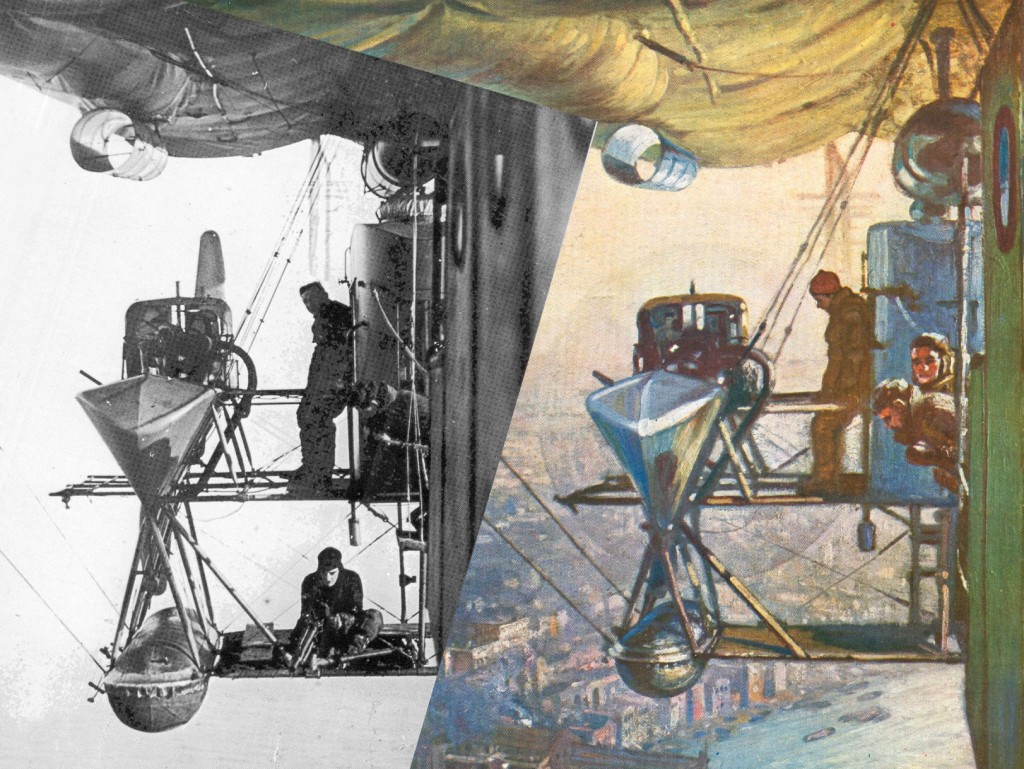This striking image, painted by Alfred Egerton Cooper (1883-1974) was published in The Sphere magazine on 6 November 1920 – another lucky find on eBay.
This painting is especially interesting as it shows NS11 above London. While it was fairly common for airships to be flown over the capital for official and semi-official reasons, it was the first record we found of NS11 being flown over London just a few weeks before the loss.
The caption for the picture reads:
London from an Airship
From a painting by Captain A E Cooper
This picture was one of the successes of the last Academy show. The artist has here pictured the outlook from one of the cabin windows of the airship “N.S.11.” Blackfriars Bridge, with its sister railway bridge, is seen spanning the river, whilst Temple lawns and trees are seen in the left foreground. The training ship “President” is seen floating off the Embankment, a vessel from which many naval volunteers passed for service at sea during the war. One the airship’s mechanics, it will be remarked, is precariously perched on one of the stays leading to the engine.
We can be more precise with the date this took place from the 17 July 1919 issue of Flight magazine which states that “It is with great regret that we have to record that the British non-rigid airship N.S. 11, which cruised over London a week or so ago, met with disaster in the early hours of Tuesday morning, while cruising off Morston, near Blakeney.”
We can be fairly certain that Cooper used a photograph for reference for the painting. This image shows the painting and photograph side by side. The gunner has been removed (quite understandably), but so many of the details and reflections in the photograph have been included.
Alfred Egerton Cooper studied art at the Bilston School of Art and at the Royal College of Art, where he received his diploma in 1911. He then worked as assistant to John Singer Sargent at his studio in Tite Street, Chelsea. Cooper exhibited at the Royal Academy forty times and became best known for his portraits – especially of Winston Churchill and the Royal Family.
At the start of WWI Cooper joined the 28th County of London Volunteer Regiment, the Artists Rifles. He was gassed and lost some sight in one eye. By the end of the war he was made official artist to the RAF and became an expert in the art and techniques of large scale aerial camouflage, sketching and painting landscapes from a variety of aircraft and airships. A newspaper from 1919 said, “Captain Cooper is different from all other air artists. Many men have pictured flying subjects from the ground, but he has taken his canvases and paints and brushes into the air and worked while flying. That he has been astonishingly successful – perhaps brilliantly successful is not too strong a thing to say – is there for all London to see and agree upon at present.” During September 1919 Cooper exhibited several works at Lady Sybil Grant’s Airships in Peace and War exhibition at the Prince’s Gallery, Piccadilly.
The original painting is now in the Cranfield University Collection. More of Cooper’s work can be found at the Imperial War Museum and the National Portrait Gallery.



 NS11 – As Bright As Day is very much a work in progress and has been made possible by the generous and enthusiastic support of many individuals and organisations. If you have any information, records or material relating to British NS Class airships we would be very interested to hear from you – especially anyone related to members of the crew of NS11 or any airship of the class during their service with the RNAS or RAF during and beyond WWI.
NS11 – As Bright As Day is very much a work in progress and has been made possible by the generous and enthusiastic support of many individuals and organisations. If you have any information, records or material relating to British NS Class airships we would be very interested to hear from you – especially anyone related to members of the crew of NS11 or any airship of the class during their service with the RNAS or RAF during and beyond WWI.
Latest